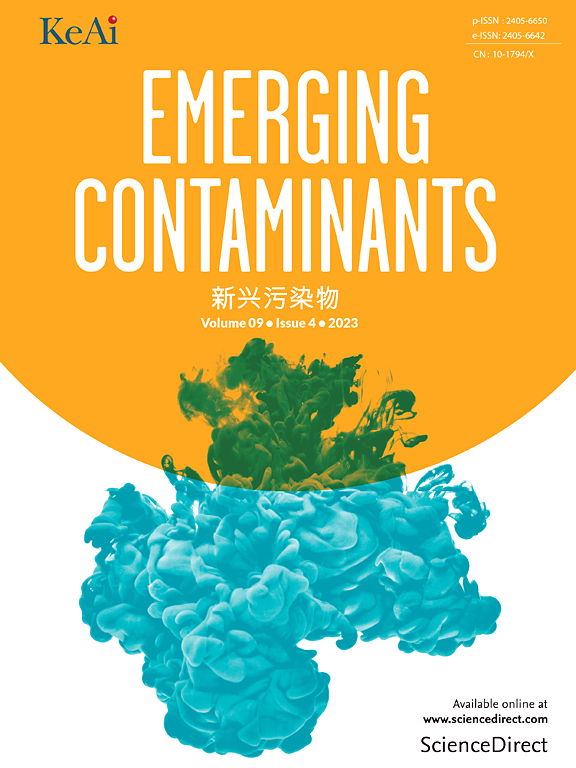糖异生的破坏是暴露于纳米塑料的大鼠雄性不育的关键媒介:体内证据和分子对接分析
IF 6.9
2区 环境科学与生态学
Q1 ENVIRONMENTAL SCIENCES
引用次数: 0
摘要
纳米塑料(NPs)已成为广泛存在的环境污染物,对多种生物系统产生了毒性影响。本研究探讨了糖异生破坏对暴露于聚苯乙烯纳米塑料的大鼠介导不育的影响。将成年雄性大鼠随机分为5组,每天口服浓度分别为0、100、200、400和800 μg/kg体重的NPs,连续55天模拟亚慢性暴露。NPs暴露诱导过多的活性氧(ROS),引发非编码RNA (tcon_00074622和tcon_00083977)、RNA甲基转移酶DNMT2上调,通过BAX激活内在凋亡,细胞色素c释放,升高caspase-9表达,损害精子发生,降低精子质量。此外,NPs暴露激活肝脏NF-κB信号传导,增加血清促炎因子(TNF-α, IL-1, IL-6),并引起肝细胞损伤,如血清AST和ALT水平升高。胰岛素下调和关键糖异生和糖原代谢基因(PCK1、G6PC1、GYS2、GLUT4和PYGL)表达改变。分子对接和动力学揭示了NPs与关键代谢蛋白(G6PC1、GLUT4、PCK-1和PYGL)的强、稳定结合,支持它们参与代谢失调。综上所述,这些发现提供了重要的体内和计算机证据,证明肝糖异生的破坏是np诱导的男性不育的中心介质。本文章由计算机程序翻译,如有差异,请以英文原文为准。
Disruption of gluconeogenesis as a key mediator of male infertility in rats exposed to nanoplastics: In vivo evidence and molecular docking analysis
Nanoplastics (NPs) have become widespread environmental pollutants with established toxicological impacts on several biological systems. This study investigates the impact of gluconeogenesis disruption in mediating infertility in rats exposed to polystyrene nanoplastics. Adult male rats were randomly assigned to five groups and orally administered NPs at concentrations of 0, 100, 200, 400, or 800 μg/kg body weight daily for 55 consecutive days to simulate subchronic exposure. NPs exposure induced excessive reactive oxygen species (ROS), which triggered upregulation of non-coding RNAs (TCONS_00074622 and TCONS_00083977), RNA methyltransferase DNMT2, activated intrinsic apoptosis via BAX, cytochrome c release, and elevated caspase-9 expression, impairing spermatogenesis and reducing sperm quality. Additionally, NPs exposure activated hepatic NF-κB signalling, increased serum pro-inflammatory cytokines (TNF-α, IL-1, IL-6), and caused hepatocellular damage, as demonstrated by increased serum AST and ALT levels. Insulin downregulation and altered expression of key gluconeogenic and glycogen metabolism genes (PCK1, G6PC1, GYS2, GLUT4, and PYGL). Molecular docking and dynamics revealed strong, stable binding of NPs to key metabolic proteins (G6PC1, GLUT4, PCK-1, and PYGL), supporting their involvement in metabolic dysregulation. Taken together, these findings provide significant in vivo and in silico evidence that disruption of hepatic gluconeogenesis serves as a central mediator of NP-induced male infertility.
求助全文
通过发布文献求助,成功后即可免费获取论文全文。
去求助
来源期刊

Emerging Contaminants
Medicine-Public Health, Environmental and Occupational Health
CiteScore
10.00
自引率
6.70%
发文量
35
审稿时长
44 days
期刊介绍:
Emerging Contaminants is an outlet for world-leading research addressing problems associated with environmental contamination caused by emerging contaminants and their solutions. Emerging contaminants are defined as chemicals that are not currently (or have been only recently) regulated and about which there exist concerns regarding their impact on human or ecological health. Examples of emerging contaminants include disinfection by-products, pharmaceutical and personal care products, persistent organic chemicals, and mercury etc. as well as their degradation products. We encourage papers addressing science that facilitates greater understanding of the nature, extent, and impacts of the presence of emerging contaminants in the environment; technology that exploits original principles to reduce and control their environmental presence; as well as the development, implementation and efficacy of national and international policies to protect human health and the environment from emerging contaminants.
 求助内容:
求助内容: 应助结果提醒方式:
应助结果提醒方式:


